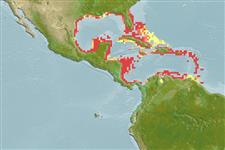Environment: milieu / climate zone / depth range / distribution range
Ecología
marino; salobre asociado a arrecife; rango de profundidad 0 - 11 m (Ref. 9710). Subtropical; 31°N - 9°N, 98°W - 59°W
Western Atlantic: northeastern Florida and northern Gulf of Mexico in the USA and the Bahamas to Campeche in Mexico and Lesser Antilles. Taxonomic status of populations from northern South America to Brazil uncertain.
Tamaño / Peso / Age
Maturity: Lm ? range ? - ? cm
Max length : 30.0 cm TL macho / no sexado; (Ref. 7251); common length : 20.0 cm TL macho / no sexado; (Ref. 3821)
Short description
Morfología | Morfometría
Espinas dorsales (total): 0; Radios blandos dorsales (total): 8; Espinas anales 0; Radios blandos anales: 7. Upper side brown with large dark grey to black spots and light (pale blue or green in fresh specimens) irregular-shaped reticulations. Lower side with an irregular row of dusky to black rounded spots. The axil spot the most intense in the series. Sexually mature, ripe males sometimes covered with brilliant red or orange spots of about 1 mm in diameter (white in preserved specimen). No lappets on head or body (Ref 53033).
Inhabits bays, estuaries and protected coastal waters. Feeds primarily on shellfish, also on some finfish (Ref. 3821).
Life cycle and mating behavior
Madurez | Reproducción | Puesta | Huevos | Fecundidad | Larva
Robins, C.R. and G.C. Ray, 1986. A field guide to Atlantic coast fishes of North America. Houghton Mifflin Company, Boston, U.S.A. 354 p. (Ref. 7251)
IUCN Red List Status (Ref. 130435)
Threat to humans
Harmless
Human uses
Pesquerías: pesquerías de subsistencia
Más información
Age/SizeCrecimientoLength-weightLength-lengthLength-frequenciesMorfometríaMorfologíaLarvaDinámica larvariaReclutamientoAbundanciaBRUVS
ReferenciasAcuiculturaPerfil de acuiculturaRazasGenéticaElectrophoresesheritabilidadEnfermedadesProcesamientoNutrientsMass conversion
ColaboradoresImágenesStamps, Coins Misc.SonidosCiguateraVelocidadTipo de nataciónSuperficie branquialOtolitosCerebrosVisión
Herramientas
Special reports
Download XML
Fuentes de Internet
Estimates based on models
Preferred temperature (Ref.
123201): 24 - 28.1, mean 27.3 °C (based on 575 cells).
Phylogenetic diversity index (Ref.
82804): PD
50 = 0.5000 [Uniqueness, from 0.5 = low to 2.0 = high].
Bayesian length-weight: a=0.02291 (0.01327 - 0.03955), b=2.85 (2.70 - 3.00), in cm total length, based on LWR estimates for this species & Genus-body shape (Ref.
93245).
Nivel trófico (Ref.
69278): 3.5 ±0.37 se; based on food items.
Resiliencia (Ref.
120179): Alto, población duplicada en un tiempo mínimo inferior a 15 meses (Preliminary K or Fecundity.).
Fishing Vulnerability (Ref.
59153): Low vulnerability (20 of 100).
Nutrients (Ref.
124155): Calcium = 31.7 [12.1, 119.3] mg/100g; Iron = 0.646 [0.304, 1.530] mg/100g; Protein = 19.4 [17.3, 21.6] %; Omega3 = 0.171 [0.083, 0.339] g/100g; Selenium = 11.4 [4.5, 28.0] μg/100g; VitaminA = 30.2 [7.5, 145.0] μg/100g; Zinc = 0.858 [0.518, 1.412] mg/100g (wet weight);
